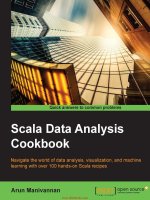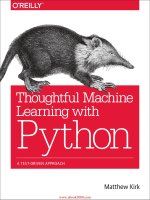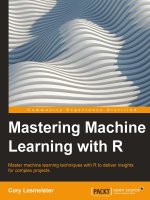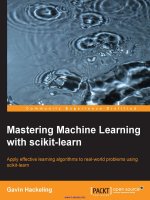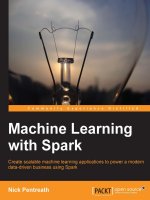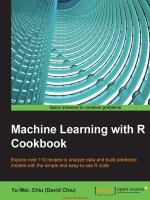IT training machine learning with spark pentreath 2014 12 08
Bạn đang xem bản rút gọn của tài liệu. Xem và tải ngay bản đầy đủ của tài liệu tại đây (4.59 MB, 338 trang )
Machine Learning with Spark
Create scalable machine learning applications to power
a modern data-driven business using Spark
Nick Pentreath
BIRMINGHAM - MUMBAI
Machine Learning with Spark
Copyright © 2015 Packt Publishing
All rights reserved. No part of this book may be reproduced, stored in a retrieval
system, or transmitted in any form or by any means, without the prior written
permission of the publisher, except in the case of brief quotations embedded in
critical articles or reviews.
Every effort has been made in the preparation of this book to ensure the accuracy
of the information presented. However, the information contained in this book is
sold without warranty, either express or implied. Neither the author, nor Packt
Publishing, and its dealers and distributors will be held liable for any damages
caused or alleged to be caused directly or indirectly by this book.
Packt Publishing has endeavored to provide trademark information about all of the
companies and products mentioned in this book by the appropriate use of capitals.
However, Packt Publishing cannot guarantee the accuracy of this information.
First published: February 2015
Production reference: 1170215
Published by Packt Publishing Ltd.
Livery Place
35 Livery Street
Birmingham B3 2PB, UK.
ISBN 978-1-78328-851-9
www.packtpub.com
Cover image by Akshay Paunikar ()
Credits
Author
Nick Pentreath
Reviewers
Project Coordinator
Milton Dsouza
Proofreaders
Andrea Mostosi
Simran Bhogal
Hao Ren
Maria Gould
Krishna Sankar
Ameesha Green
Paul Hindle
Commissioning Editor
Rebecca Youé
Indexer
Priya Sane
Acquisition Editor
Rebecca Youé
Graphics
Sheetal Aute
Content Development Editor
Susmita Sabat
Technical Editors
Vivek Arora
Pankaj Kadam
Abhinash Sahu
Production Coordinator
Nitesh Thakur
Cover Work
Nitesh Thakur
Copy Editor
Karuna Narayanan
About the Author
Nick Pentreath has a background in financial markets, machine learning, and
software development. He has worked at Goldman Sachs Group, Inc.; as a research
scientist at the online ad targeting start-up Cognitive Match Limited, London; and
led the Data Science and Analytics team at Mxit, Africa's largest social network.
He is a cofounder of Graphflow, a big data and machine learning company focused
on user-centric recommendations and customer intelligence. He is passionate about
combining commercial focus with machine learning and cutting-edge technology to
build intelligent systems that learn from data to add value to the bottom line.
Nick is a member of the Apache Spark Project Management Committee.
Acknowledgments
Writing this book has been quite a rollercoaster ride over the past year, with many
ups and downs, late nights, and working weekends. It has also been extremely
rewarding to combine my passion for machine learning with my love of the Apache
Spark project, and I hope to bring some of this out in this book.
I would like to thank the Packt Publishing team for all their assistance throughout
the writing and editing process: Rebecca, Susmita, Sudhir, Amey, Neil, Vivek,
Pankaj, and everyone who worked on the book.
Thanks also go to Debora Donato at StumbleUpon for assistance with data- and
legal-related queries.
Writing a book like this can be a somewhat lonely process, so it is incredibly helpful
to get the feedback of reviewers to understand whether one is headed in the right
direction (and what course adjustments need to be made). I'm deeply grateful to
Andrea Mostosi, Hao Ren, and Krishna Sankar for taking the time to provide such
detailed and critical feedback.
I could not have gotten through this project without the unwavering support of all
my family and friends, especially my wonderful wife, Tammy, who will be glad to
have me back in the evenings and on weekends once again. Thank you all!
Finally, thanks to all of you reading this; I hope you find it useful!
About the Reviewers
Andrea Mostosi is a technology enthusiast. An innovation lover since he was a
child, he started a professional job in 2003 and worked on several projects, playing
almost every role in the computer science environment. He is currently the CTO at
The Fool, a company that tries to make sense of web and social data. During his free
time, he likes traveling, running, cooking, biking, and coding.
I would like to thank my geek friends: Simone M, Daniele V, Luca T,
Luigi P, Michele N, Luca O, Luca B, Diego C, and Fabio B. They are
the smartest people I know, and comparing myself with them has
always pushed me to be better.
Hao Ren is a software developer who is passionate about Scala, distributed
systems, machine learning, and Apache Spark. He was an exchange student at EPFL
when he learned about Scala in 2012. He is currently working in Paris as a backend
and data engineer for ClaraVista—a company that focuses on high-performance
marketing. His work responsibility is to build a Spark-based platform for purchase
prediction and a new recommender system.
Besides programming, he enjoys running, swimming, and playing basketball and
badminton. You can learn more at his blog .
Krishna Sankar is a chief data scientist at BlackArrow, where he is focusing
on enhancing user experience via inference, intelligence, and interfaces. Earlier
stints include working as a principal architect and data scientist at Tata America
International Corporation, director of data science at a bioinformatics start-up
company, and as a distinguished engineer at Cisco Systems, Inc. He has spoken at
various conferences about data science ( machine learning
( and social media analysis ( He
has also been a guest lecturer at the Naval Postgraduate School. He has written a few
books on Java, wireless LAN security, Web 2.0, and now on Spark. His other passion
is LEGO robotics. Earlier in April, he was at the St. Louis FLL World Competition as
a robots design judge.
www.PacktPub.com
Support files, eBooks, discount offers, and more
For support files and downloads related to your book, please visit
www.PacktPub.com.
Did you know that Packt offers eBook versions of every book published, with PDF
and ePub files available? You can upgrade to the eBook version at www.PacktPub.
com and as a print book customer, you are entitled to a discount on the eBook copy.
Get in touch with us at for more details.
At www.PacktPub.com, you can also read a collection of free technical articles,
sign up for a range of free newsletters and receive exclusive discounts and offers
on Packt books and eBooks.
TM
/>
Do you need instant solutions to your IT questions? PacktLib is Packt's online digital
book library. Here, you can search, access, and read Packt's entire library of books.
Why subscribe?
• Fully searchable across every book published by Packt
• Copy and paste, print, and bookmark content
• On demand and accessible via a web browser
Free access for Packt account holders
If you have an account with Packt at www.PacktPub.com, you can use this to access
PacktLib today and view 9 entirely free books. Simply use your login credentials for
immediate access.
Table of Contents
Preface1
Chapter 1: Getting Up and Running with Spark
7
Installing and setting up Spark locally
Spark clusters
The Spark programming model
SparkContext and SparkConf
The Spark shell
Resilient Distributed Datasets
8
10
11
11
12
14
Broadcast variables and accumulators
The first step to a Spark program in Scala
The first step to a Spark program in Java
The first step to a Spark program in Python
Getting Spark running on Amazon EC2
Launching an EC2 Spark cluster
Summary
19
21
24
28
30
31
35
Creating RDDs
Spark operations
Caching RDDs
Chapter 2: Designing a Machine Learning System
15
15
18
37
Introducing MovieStream
38
Business use cases for a machine learning system
39
Personalization40
Targeted marketing and customer segmentation
40
Predictive modeling and analytics
41
Types of machine learning models
41
The components of a data-driven machine learning system
42
Data ingestion and storage
42
Data cleansing and transformation
43
Table of Contents
Model training and testing loop
Model deployment and integration
Model monitoring and feedback
Batch versus real time
An architecture for a machine learning system
Practical exercise
Summary
Chapter 3: Obtaining, Processing, and Preparing Data
with Spark
Accessing publicly available datasets
The MovieLens 100k dataset
Exploring and visualizing your data
Exploring the user dataset
Exploring the movie dataset
Exploring the rating dataset
Processing and transforming your data
Filling in bad or missing data
Extracting useful features from your data
Numerical features
Categorical features
Derived features
Transforming timestamps into categorical features
45
45
45
47
48
49
50
51
52
54
55
57
62
64
68
69
70
71
71
73
73
Text features
75
Normalizing features
80
Simple text feature extraction
76
Using MLlib for feature normalization
Using packages for feature extraction
Summary
Chapter 4: Building a Recommendation Engine with Spark
Types of recommendation models
Content-based filtering
Collaborative filtering
Matrix factorization
81
82
82
83
84
85
85
86
Extracting the right features from your data
Extracting features from the MovieLens 100k dataset
Training the recommendation model
Training a model on the MovieLens 100k dataset
92
92
96
96
Using the recommendation model
User recommendations
99
99
Training a model using implicit feedback data
Generating movie recommendations from the MovieLens 100k dataset
[ ii ]
98
99
Table of Contents
Item recommendations
Generating similar movies for the MovieLens 100k dataset
102
103
Evaluating the performance of recommendation models
Mean Squared Error
Mean average precision at K
Using MLlib's built-in evaluation functions
106
107
109
113
Summary
115
RMSE and MSE
113
MAP113
Chapter 5: Building a Classification Model with Spark
Types of classification models
Linear models
Logistic regression
Linear support vector machines
The naïve Bayes model
Decision trees
Extracting the right features from your data
Extracting features from the Kaggle/StumbleUpon
evergreen classification dataset
Training classification models
Training a classification model on the Kaggle/StumbleUpon
evergreen classification dataset
Using classification models
Generating predictions for the Kaggle/StumbleUpon
evergreen classification dataset
Evaluating the performance of classification models
Accuracy and prediction error
Precision and recall
ROC curve and AUC
Improving model performance and tuning parameters
Feature standardization
Additional features
Using the correct form of data
Tuning model parameters
Linear models
Decision trees
The naïve Bayes model
117
120
120
122
123
124
126
128
128
130
131
133
133
134
134
136
138
140
141
144
147
148
149
154
155
Cross-validation156
Summary
159
[ iii ]
Table of Contents
Chapter 6: Building a Regression Model with Spark
Types of regression models
Least squares regression
Decision trees for regression
Extracting the right features from your data
Extracting features from the bike sharing dataset
Creating feature vectors for the linear model
Creating feature vectors for the decision tree
161
162
162
163
164
164
168
169
Training and using regression models
Training a regression model on the bike sharing dataset
Evaluating the performance of regression models
Mean Squared Error and Root Mean Squared Error
Mean Absolute Error
Root Mean Squared Log Error
The R-squared coefficient
Computing performance metrics on the bike sharing dataset
170
171
173
173
174
174
175
175
Improving model performance and tuning parameters
Transforming the target variable
177
177
Linear model
Decision tree
Impact of training on log-transformed targets
Tuning model parameters
Creating training and testing sets to evaluate parameters
The impact of parameter settings for linear models
The impact of parameter settings for the decision tree
Summary
Chapter 7: Building a Clustering Model with Spark
Types of clustering models
K-means clustering
175
176
180
183
183
184
192
195
197
198
198
Initialization methods
202
Variants203
Mixture models
Hierarchical clustering
Extracting the right features from your data
Extracting features from the MovieLens dataset
203
203
204
204
Training a clustering model
Training a clustering model on the MovieLens dataset
Making predictions using a clustering model
Interpreting cluster predictions on the MovieLens dataset
208
208
210
211
Extracting movie genre labels
205
Training the recommendation model
207
Normalization207
Interpreting the movie clusters
[ iv ]
212
Table of Contents
Evaluating the performance of clustering models
Internal evaluation metrics
External evaluation metrics
Computing performance metrics on the MovieLens dataset
Tuning parameters for clustering models
Selecting K through cross-validation
Summary
Chapter 8: Dimensionality Reduction with Spark
Types of dimensionality reduction
Principal Components Analysis
Singular Value Decomposition
Relationship with matrix factorization
Clustering as dimensionality reduction
Extracting the right features from your data
Extracting features from the LFW dataset
216
216
216
217
217
217
219
221
222
222
223
224
224
225
225
Exploring the face data
226
Visualizing the face data
228
Extracting facial images as vectors
229
Normalization233
Training a dimensionality reduction model
Running PCA on the LFW dataset
234
235
Using a dimensionality reduction model
Projecting data using PCA on the LFW dataset
The relationship between PCA and SVD
Evaluating dimensionality reduction models
Evaluating k for SVD on the LFW dataset
Summary
238
239
240
242
242
245
Visualizing the Eigenfaces
Interpreting the Eigenfaces
Chapter 9: Advanced Text Processing with Spark
What's so special about text data?
Extracting the right features from your data
Term weighting schemes
Feature hashing
Extracting the TF-IDF features from the 20 Newsgroups dataset
Exploring the 20 Newsgroups data
Applying basic tokenization
Improving our tokenization
Removing stop words
Excluding terms based on frequency
A note about stemming
Training a TF-IDF model
Analyzing the TF-IDF weightings
[v]
236
238
247
247
248
248
249
251
253
255
256
258
261
264
264
266
Table of Contents
Using a TF-IDF model
Document similarity with the 20 Newsgroups dataset and
TF-IDF features
Training a text classifier on the 20 Newsgroups dataset
using TF-IDF
Evaluating the impact of text processing
Comparing raw features with processed TF-IDF features on the
20 Newsgroups dataset
Word2Vec models
Word2Vec on the 20 Newsgroups dataset
Summary
Chapter 10: Real-time Machine Learning with Spark Streaming
Online learning
Stream processing
An introduction to Spark Streaming
268
268
271
273
273
274
275
278
279
279
281
281
Input sources
282
Transformations282
Actions284
Window operators
284
Caching and fault tolerance with Spark Streaming
Creating a Spark Streaming application
The producer application
Creating a basic streaming application
Streaming analytics
Stateful streaming
Online learning with Spark Streaming
Streaming regression
A simple streaming regression program
285
286
287
290
293
296
298
298
299
Streaming K-means
Online model evaluation
Comparing model performance with Spark Streaming
Summary
305
306
306
310
Creating a streaming data producer
Creating a streaming regression model
Index
[ vi ]
299
302
311
Preface
In recent years, the volume of data being collected, stored, and analyzed has
exploded, in particular in relation to the activity on the Web and mobile devices, as
well as data from the physical world collected via sensor networks. While previously
large-scale data storage, processing, analysis, and modeling was the domain of the
largest institutions such as Google, Yahoo!, Facebook, and Twitter, increasingly,
many organizations are being faced with the challenge of how to handle a massive
amount of data.
When faced with this quantity of data and the common requirement to utilize it in
real time, human-powered systems quickly become infeasible. This has led to a rise
in the so-called big data and machine learning systems that learn from this data to
make automated decisions.
In answer to the challenge of dealing with ever larger-scale data without any
prohibitive cost, new open source technologies emerged at companies such as
Google, Yahoo!, Amazon, and Facebook, which aimed at making it easier to handle
massive data volumes by distributing data storage and computation across a cluster
of computers.
The most widespread of these is Apache Hadoop, which made it significantly easier
and cheaper to both store large amounts of data (via the Hadoop Distributed File
System, or HDFS) and run computations on this data (via Hadoop MapReduce,
a framework to perform computation tasks in parallel across many nodes in a
computer cluster).
Preface
However, MapReduce has some important shortcomings, including high overheads
to launch each job and reliance on storing intermediate data and results of the
computation to disk, both of which make Hadoop relatively ill-suited for use cases of
an iterative or low-latency nature. Apache Spark is a new framework for distributed
computing that is designed from the ground up to be optimized for low-latency
tasks and to store intermediate data and results in memory, thus addressing some of
the major drawbacks of the Hadoop framework. Spark provides a clean, functional,
and easy-to-understand API to write applications and is fully compatible with the
Hadoop ecosystem.
Furthermore, Spark provides native APIs in Scala, Java, and Python. The Scala and
Python APIs allow all the benefits of the Scala or Python language, respectively,
to be used directly in Spark applications, including using the relevant interpreter
for real-time, interactive exploration. Spark itself now provides a toolkit (called
MLlib) of distributed machine learning and data mining models that is under heavy
development and already contains high-quality, scalable, and efficient algorithms for
many common machine learning tasks, some of which we will delve into in this book.
Applying machine learning techniques to massive datasets is challenging, primarily
because most well-known machine learning algorithms are not designed for parallel
architectures. In many cases, designing such algorithms is not an easy task. The
nature of machine learning models is generally iterative, hence the strong appeal
of Spark for this use case. While there are many competing frameworks for parallel
computing, Spark is one of the few that combines speed, scalability, in-memory
processing, and fault tolerance with ease of programming and a flexible, expressive,
and powerful API design.
Throughout this book, we will focus on real-world applications of machine learning
technology. While we may briefly delve into some theoretical aspects of machine
learning algorithms, the book will generally take a practical, applied approach with
a focus on using examples and code to illustrate how to effectively use the features
of Spark and MLlib, as well as other well-known and freely available packages for
machine learning and data analysis, to create a useful machine learning system.
What this book covers
Chapter 1, Getting Up and Running with Spark, shows how to install and set up a local
development environment for the Spark framework as well as how to create a Spark
cluster in the cloud using Amazon EC2. The Spark programming model and API will
be introduced, and a simple Spark application will be created using each of Scala,
Java, and Python.
[2]
Preface
Chapter 2, Designing a Machine Learning System, presents an example of a real-world
use case for a machine learning system. We will design a high-level architecture for
an intelligent system in Spark based on this illustrative use case.
Chapter 3, Obtaining, Processing, and Preparing Data with Spark, details how to go about
obtaining data for use in a machine learning system, in particular from various freely
and publicly available sources. We will learn how to process, clean, and transform
the raw data into features that may be used in machine learning models, using
available tools, libraries, and Spark's functionality.
Chapter 4, Building a Recommendation Engine with Spark, deals with creating a
recommendation model based on the collaborative filtering approach. This model
will be used to recommend items to a given user as well as create lists of items
that are similar to a given item. Standard metrics to evaluate the performance of a
recommendation model will be covered here.
Chapter 5, Building a Classification Model with Spark, details how to create a model
for binary classification as well as how to utilize standard performance-evaluation
metrics for classification tasks.
Chapter 6, Building a Regression Model with Spark, shows how to create a model
for regression, extending the classification model created in Chapter 5, Building a
Classification Model with Spark. Evaluation metrics for the performance of regression
models will be detailed here.
Chapter 7, Building a Clustering Model with Spark, explores how to create a clustering
model as well as how to use related evaluation methodologies. You will learn how to
analyze and visualize the clusters generated.
Chapter 8, Dimensionality Reduction with Spark, takes us through methods to extract
the underlying structure from and reduce the dimensionality of our data. You will
learn some common dimensionality-reduction techniques and how to apply and
analyze them, as well as how to use the resulting data representation as input to
another machine learning model.
Chapter 9, Advanced Text Processing with Spark, introduces approaches to deal with
large-scale text data, including techniques for feature extraction from text and
dealing with the very high-dimensional features typical in text data.
Chapter 10, Real-time Machine Learning with Spark Streaming, provides an overview
of Spark Streaming and how it fits in with the online and incremental learning
approaches to apply machine learning on data streams.
[3]
Preface
What you need for this book
Throughout this book, we assume that you have some basic experience with
programming in Scala, Java, or Python and have some basic knowledge of
machine learning, statistics, and data analysis.
Who this book is for
This book is aimed at entry-level to intermediate data scientists, data analysts, software
engineers, and practitioners involved in machine learning or data mining with an
interest in large-scale machine learning approaches, but who are not necessarily
familiar with Spark. You may have some experience of statistics or machine learning
software (perhaps including MATLAB, scikit-learn, Mahout, R, Weka, and so on) or
distributed systems (perhaps including some exposure to Hadoop).
Conventions
In this book, you will find a number of styles of text that distinguish between
different kinds of information. Here are some examples of these styles, and an
explanation of their meaning.
Code words in text, database table names, folder names, filenames, file extensions,
pathnames, dummy URLs, user input, and Twitter handles are shown as follows:
"Spark places user scripts to run Spark in the bin directory."
A block of code is set as follows:
val conf = new SparkConf()
.setAppName("Test Spark App")
.setMaster("local[4]")
val sc = new SparkContext(conf)
Any command-line input or output is written as follows:
>tar xfvz spark-1.2.0-bin-hadoop2.4.tgz
>cd spark-1.2.0-bin-hadoop2.4
[4]
Preface
New terms and important words are shown in bold. Words that you see on the
screen, in menus or dialog boxes for example, appear in the text like this: "These can
be obtained from the AWS homepage by clicking Account | Security Credentials |
Access Credentials."
Warnings or important notes appear in a box like this.
Tips and tricks appear like this.
Reader feedback
Feedback from our readers is always welcome. Let us know what you think about
this book—what you liked or may have disliked. Reader feedback is important for
us to develop titles that you really get the most out of.
To send us general feedback, simply send an e-mail to ,
and mention the book title through the subject of your message.
If there is a topic that you have expertise in and you are interested in either writing
or contributing to a book, see our author guide on www.packtpub.com/authors.
Customer support
Now that you are the proud owner of a Packt book, we have a number of things to
help you to get the most from your purchase.
Downloading the example code
You can download the example code files for all Packt books you have purchased
from your account at . If you purchased this book
elsewhere, you can visit and register to have
the files e-mailed directly to you.
[5]
Errata
Although we have taken every care to ensure the accuracy of our content, mistakes
do happen. If you find a mistake in one of our books—maybe a mistake in the text or
the code—we would be grateful if you would report this to us. By doing so, you can
save other readers from frustration and help us improve subsequent versions of this
book. If you find any errata, please report them by visiting ktpub.
com/support, selecting your book, clicking on the Errata Submission Form link, and
entering the details of your errata. Once your errata are verified, your submission
will be accepted and the errata will be uploaded to our website or added to any list
of existing errata under the Errata section of that title.
To view the previously submitted errata, go to />content/support and enter the name of the book in the search field. The required
information will appear under the Errata section.
Piracy
Piracy of copyright material on the Internet is an ongoing problem across all media.
At Packt, we take the protection of our copyright and licenses very seriously. If you
come across any illegal copies of our works, in any form, on the Internet, please
provide us with the location address or website name immediately so that we can
pursue a remedy.
Please contact us at with a link to the suspected
pirated material.
We appreciate your help in protecting our authors, and our ability to bring you
valuable content.
Questions
You can contact us at if you are having a problem with
any aspect of the book, and we will do our best to address it.
Getting Up and Running
with Spark
Apache Spark is a framework for distributed computing; this framework aims to
make it simpler to write programs that run in parallel across many nodes in a cluster
of computers. It tries to abstract the tasks of resource scheduling, job submission,
execution, tracking, and communication between nodes, as well as the low-level
operations that are inherent in parallel data processing. It also provides a higher
level API to work with distributed data. In this way, it is similar to other distributed
processing frameworks such as Apache Hadoop; however, the underlying
architecture is somewhat different.
Spark began as a research project at the University of California, Berkeley. The
university was focused on the use case of distributed machine learning algorithms.
Hence, it is designed from the ground up for high performance in applications of an
iterative nature, where the same data is accessed multiple times. This performance is
achieved primarily through caching datasets in memory, combined with low latency
and overhead to launch parallel computation tasks. Together with other features
such as fault tolerance, flexible distributed-memory data structures, and a powerful
functional API, Spark has proved to be broadly useful for a wide range of large-scale
data processing tasks, over and above machine learning and iterative analytics.
For more background on Spark, including the research papers
underlying Spark's development, see the project's history page at
/>
Getting Up and Running with Spark
Spark runs in four modes:
• The standalone local mode, where all Spark processes are run within the
same Java Virtual Machine (JVM) process
• The standalone cluster mode, using Spark's own built-in job-scheduling
framework
• Using Mesos, a popular open source cluster-computing framework
• Using YARN (commonly referred to as NextGen MapReduce), a
Hadoop-related cluster-computing and resource-scheduling framework
In this chapter, we will:
• Download the Spark binaries and set up a development environment that
runs in Spark's standalone local mode. This environment will be used
throughout the rest of the book to run the example code.
• Explore Spark's programming model and API using Spark's interactive
console.
• Write our first Spark program in Scala, Java, and Python.
• Set up a Spark cluster using Amazon's Elastic Cloud Compute (EC2)
platform, which can be used for large-sized data and heavier computational
requirements, rather than running in the local mode.
Spark can also be run on Amazon's Elastic MapReduce service using
custom bootstrap action scripts, but this is beyond the scope of this book.
The following article is a good reference guide: zon.
com/articles/Elastic-MapReduce/4926593393724923.
At the time of writing this book, the article covers running Spark
Version 1.1.0.
If you have previous experience in setting up Spark and are familiar with the basics
of writing a Spark program, feel free to skip this chapter.
Installing and setting up Spark locally
Spark can be run using the built-in standalone cluster scheduler in the local mode.
This means that all the Spark processes are run within the same JVM—effectively,
a single, multithreaded instance of Spark. The local mode is very useful for
prototyping, development, debugging, and testing. However, this mode can also be
useful in real-world scenarios to perform parallel computation across multiple cores
on a single computer.
[8]
Chapter 1
As Spark's local mode is fully compatible with the cluster mode, programs written
and tested locally can be run on a cluster with just a few additional steps.
The first step in setting up Spark locally is to download the latest version (at the time
of writing this book, the version is 1.2.0). The download page of the Spark project
website, found at contains links to
download various versions as well as to obtain the latest source code via GitHub.
The Spark project documentation website at che.
org/docs/latest/ is a comprehensive resource to learn more about
Spark. We highly recommend that you explore it!
Spark needs to be built against a specific version of Hadoop in order to access
Hadoop Distributed File System (HDFS) as well as standard and custom Hadoop
input sources. The download page provides prebuilt binary packages for Hadoop 1,
CDH4 (Cloudera's Hadoop Distribution), MapR's Hadoop distribution, and Hadoop
2 (YARN). Unless you wish to build Spark against a specific Hadoop version, we
recommend that you download the prebuilt Hadoop 2.4 package from an Apache
mirror using this link: />spark-1.2.0/spark-1.2.0-bin-hadoop2.4.tgz.
Spark requires the Scala programming language (version 2.10.4 at the time of writing
this book) in order to run. Fortunately, the prebuilt binary package comes with the
Scala runtime packages included, so you don't need to install Scala separately in
order to get started. However, you will need to have a Java Runtime Environment
(JRE) or Java Development Kit (JDK) installed (see the software and hardware list
in this book's code bundle for installation instructions).
Once you have downloaded the Spark binary package, unpack the contents
of the package and change into the newly created directory by running the
following commands:
>tar xfvz spark-1.2.0-bin-hadoop2.4.tgz
>cd spark-1.2.0-bin-hadoop2.4
Spark places user scripts to run Spark in the bin directory. You can test whether
everything is working correctly by running one of the example programs included
in Spark:
>./bin/run-example org.apache.spark.examples.SparkPi
[9]
Getting Up and Running with Spark
This will run the example in Spark's local standalone mode. In this mode, all the Spark
processes are run within the same JVM, and Spark uses multiple threads for parallel
processing. By default, the preceding example uses a number of threads equal to the
number of cores available on your system. Once the program is finished running, you
should see something similar to the following lines near the end of the output:
…
14/11/27 20:58:47 INFO SparkContext: Job finished: reduce at SparkPi.
scala:35, took 0.723269 s
Pi is roughly 3.1465
…
To configure the level of parallelism in the local mode, you can pass in a master
parameter of the local[N] form, where N is the number of threads to use. For
example, to use only two threads, run the following command instead:
>MASTER=local[2] ./bin/run-example org.apache.spark.examples.SparkPi
Spark clusters
A Spark cluster is made up of two types of processes: a driver program and multiple
executors. In the local mode, all these processes are run within the same JVM. In a
cluster, these processes are usually run on separate nodes.
For example, a typical cluster that runs in Spark's standalone mode (that is, using
Spark's built-in cluster-management modules) will have:
• A master node that runs the Spark standalone master process as well as the
driver program
• A number of worker nodes, each running an executor process
While we will be using Spark's local standalone mode throughout this book to
illustrate concepts and examples, the same Spark code that we write can be run
on a Spark cluster. In the preceding example, if we run the code on a Spark
standalone cluster, we could simply pass in the URL for the master node as follows:
>MASTER=spark://IP:PORT ./bin/run-example org.apache.spark.examples.
SparkPi
[ 10 ]

